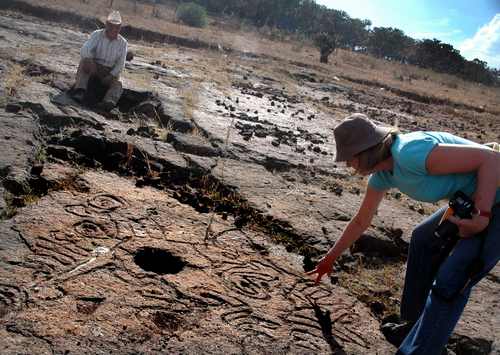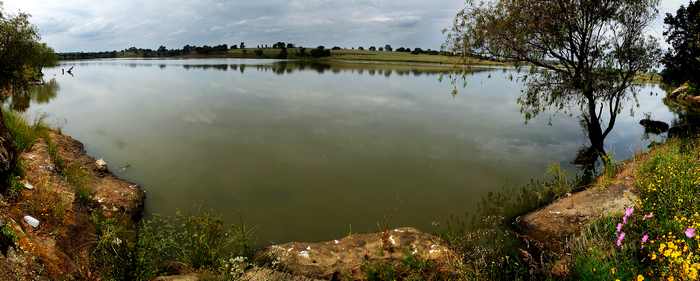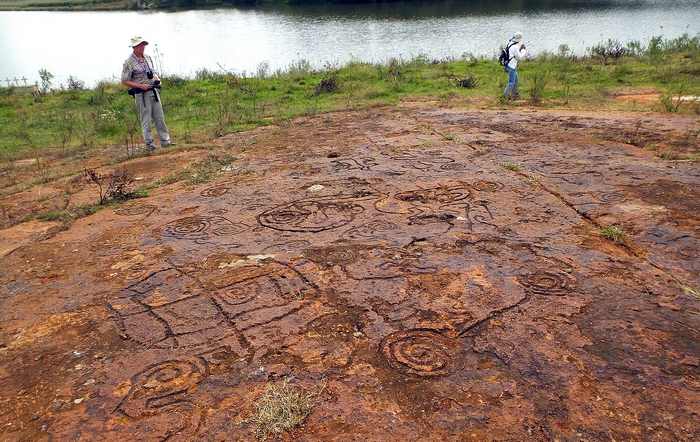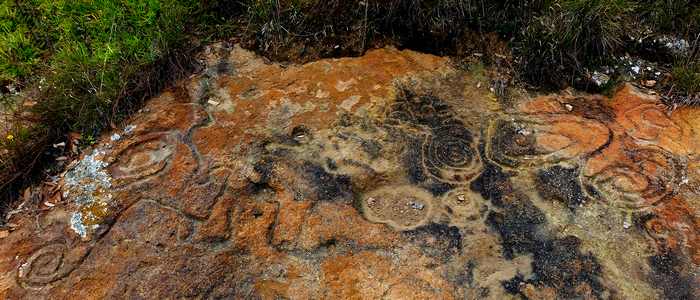By John Pint
 “We
want to show you
some petroglyphs located not far from Arandas. We’ve never seen
anything like them before.” This email message immediately grabbed my
attention because it had been sent by two archaeologists, Rodrigo and
Cyntia Esparza. If the Esparzas considered this rock art
extraordinary, I told myself, it must be extraordinary indeed. So, I
made an extra effort to try to set up an expedition to Arandas, which
is located about 100 kilometers east of Guadalajara, Mexico's
second-largest city. Getting there was not exactly easy because the
site was at the end of “un camino feo” (literally, an
ugly road) and only high-clearance vehicles would be suitable for
reaching the place. “We
want to show you
some petroglyphs located not far from Arandas. We’ve never seen
anything like them before.” This email message immediately grabbed my
attention because it had been sent by two archaeologists, Rodrigo and
Cyntia Esparza. If the Esparzas considered this rock art
extraordinary, I told myself, it must be extraordinary indeed. So, I
made an extra effort to try to set up an expedition to Arandas, which
is located about 100 kilometers east of Guadalajara, Mexico's
second-largest city. Getting there was not exactly easy because the
site was at the end of “un camino feo” (literally, an
ugly road) and only high-clearance vehicles would be suitable for
reaching the place.
A few weeks later, in a
Jeep borrowed from a friend of a friend, we found ourselves driving
through Arandas. A short while later we arrived at a farm under the
care of 79-year-old Don José Flores, who led us toward the edge of a
nice-looking lake just below the farmhouse. Two minutes later, we found
ourselves surrounded by petroglyphs. These were not on a rock or a
canyon wall but spread all over the ground beneath our feet, something
I had never seen before. The “ground,” in this case, was a wide expanse
of rather smooth, relatively soft volcanic rock from which a thin layer
of topsoil had been removed very recently when someone pointed out part
of a petroglyph to the owner. To everyone’s surprise, the more dirt
they removed, the more petroglyphs were found. 
Presa de la Luz, Jalisco, Mexico
Only a few
of the
engravings suggested something recognizable, like an animal. Some were
truly elaborate and bizarre (to modern eyes) and a great many of the
glyphs had at least one spiral worked into the design or attached to
one end of it.
Don José then said we
should take a look at other engravings he had spotted “just 15 minutes
away.” Well, the minutes soon turned into hours as we examined more and
more rock art on both sides of the lake. In several places we found
Pecked Crosses in which the lines of the cross were perfectly oriented
with the four cardinal directions, inside two concentric circles or
squares made up of a great many tiny pits (“pocitos” the
archaelogists called them) which, in some cases total up to
260, exactly the number of days in a Mesoamerican, PreHispanic year.
Some of the most famous Pecked Crosses were found long ago at
Teotihuacán and were thought to have a calendric purpose. In addition,
the four ends of the cross always point north, south, east and west.
It's possible that a
small red bean called a patolli may have been moved from pit to pit to
keep track of “today” on this simple calendar.
Near the end of the day,
a member of our group, Andrew Taylor, spotted one or two of these tiny
pits in a little patch of exposed rock and we all drew together to
watch him brush away the earth, revealing a very big Pecked Cross—at
least one meter in diameter—which Don José had not known about.
How old are the engravings? “They were made about 1100 years ago,” said
Cyntia Esparza. “And they are already being destroyed,” added her
husband Rodrigo, “by people walking on them.” Indeed, we even found one
elaborate representation of a bird (or so we thought) underneath the
ashes of a fire someone had recently built exactly there. 
El Planchón Principal, the biggest single display of petroglyphs at Presa de la Luz
“This project began in
2012,” Rodrigo Esparza told me. “In our first field-work session, we
hired 52 people to clean around the perimeter of the lake. This
resulted in welcome work for the local people and exposed a great many
petrograbados we hadn't seen before. Once the area had been cleaned up,
we got started registering each petroglyph. That year we found about
105 along the lake shore. Many of them were Pecked Crosses.”
“In 2013,” continued
Esparza, “we had a second field-work session registering rock art a
little farther from the dam, in an area covering about 40 hectares.
Here we found many more petroglyphs, which brought the total number up
to 600. It was impressive! During this season, we organized another
clean-up and a reforestation project in which more than 5,000 trees of
various species were planted.”
Susy and I, along with
geologist Chris Lloyd, had been invited along to help hunt for new
petroglyphs not yet registered. Guided by Don José, we drove to a
gently sloping hillside where we found lots of barbed-wire fences and
plenty of rock art.
The very
first example didn't look much like art at all. It was just a hole
about ten centimeters wide and 7 deep, nicely rounded. Carving a hole
like this, according to archaeologist Joseph Mountjoy, was a very
simple way of asking the gods for rain and is probably the most common
petrograbado of all. “We found a cave not far from here with hundreds
of pocitos like this one,” commented Esparza.
The
next most common symbol we saw was the spiral, another prayer for rain.
By the end of the day, we had seen a good cross-section of the
petroglyphs at Presa de la Luz and I noticed one characteristic many of
them had in common: each image has been drawn with a single line. If
you challenge someone to draw a mouse or a bird without once lifting
their pencil from the paper, they could do it, but this certainly is
not the easiest way to draw. The result of such a drawing is something
like a maze with one beginning and one end.
Why
did these ancient people use this style? Well, it seems to me the
“line” is a channel, along which you could move a pebble, as if in a
board game or in which you could pour water (or some other liquid). You
could even place beetles in the channel, at each extreme and then bet
on which will make it all the way to the opposite end. These things are
possible only with horizontally situated petroglyphs. Exactly what the
engravings at Presa de la Luz mean--and how they were used--is a
mystery at the moment.
The
rock in which they are sculpted is also mysterious. “This rock is
lithic ignimbrite,” Chris Lloyd told me. “This means it flowed here
from a volcanic source no more than ten or twelve kilometers away.”
Finding the source may represent an interesting challenge for
geologists.
These
are some of the discoveries made at Presa de la Luz during season
three, which is now drawing to a close. Says archaeologist Rodrigo
Esparza: “As of this moment, we have registered exactly 666
petroglyphs, but don't worry, we'll get past that particular number
very quickly. What's exciting is that we've already found eleven of the
famous Pecked Crosses... and recently we have also found the ruins of
two ancient ceremonial sites near here, which we need to take a look
at. I'm afraid it will still be a number of years before we are able to
open this amazing archaeological site to the public.”
 Newly discovered petroglyphs at Presa de la Luz
|

